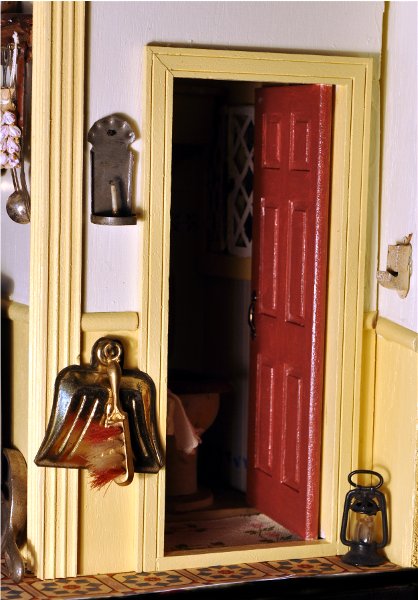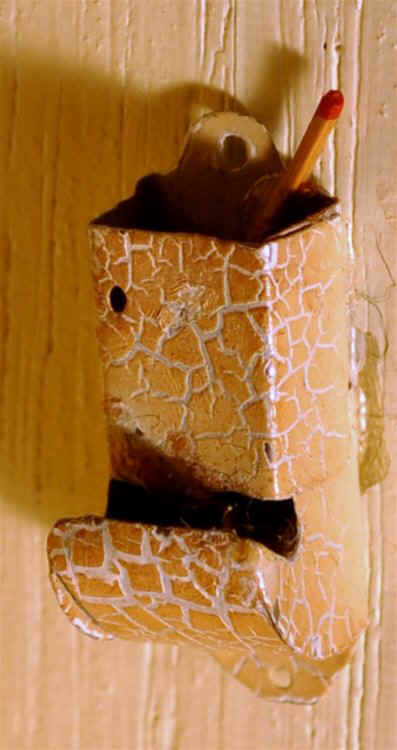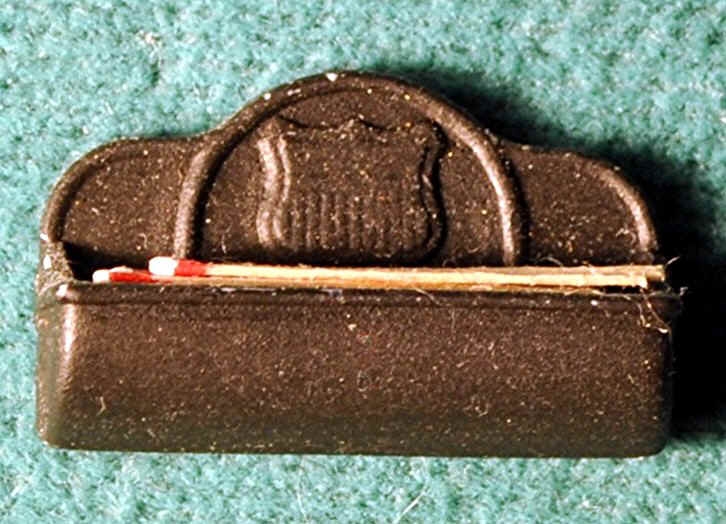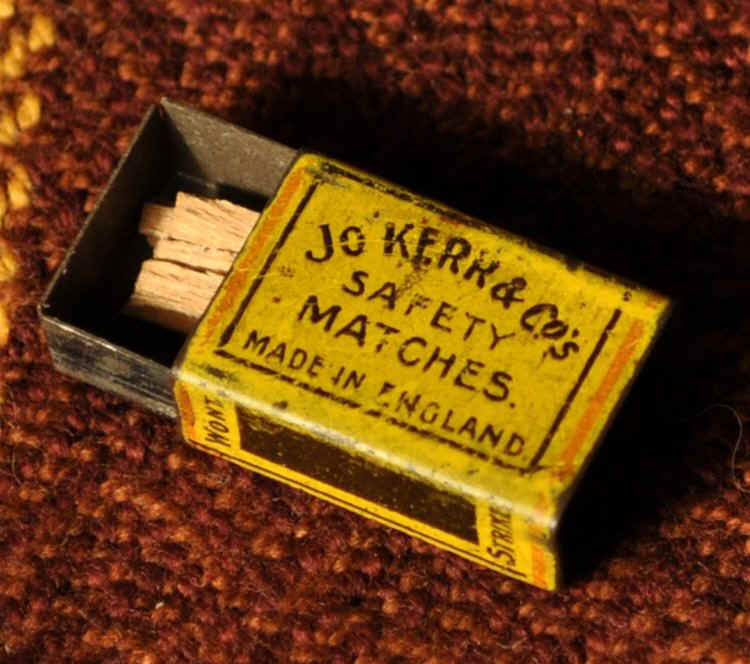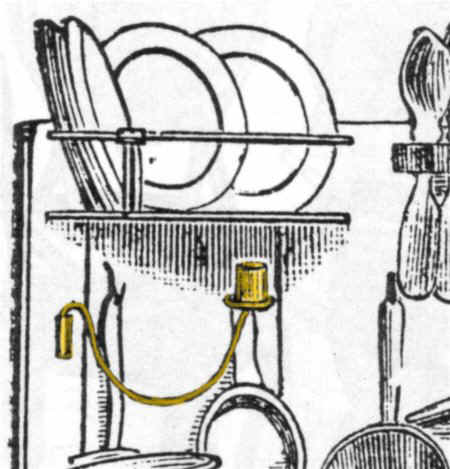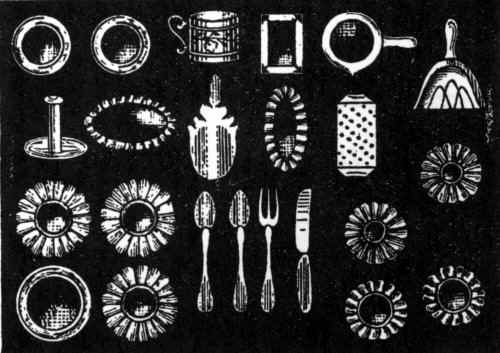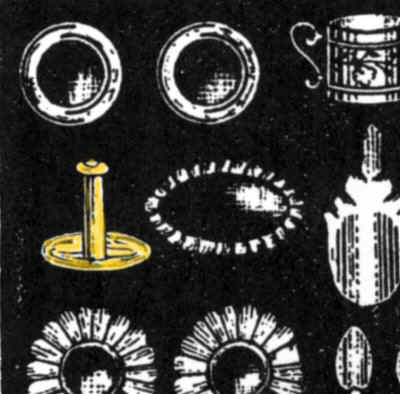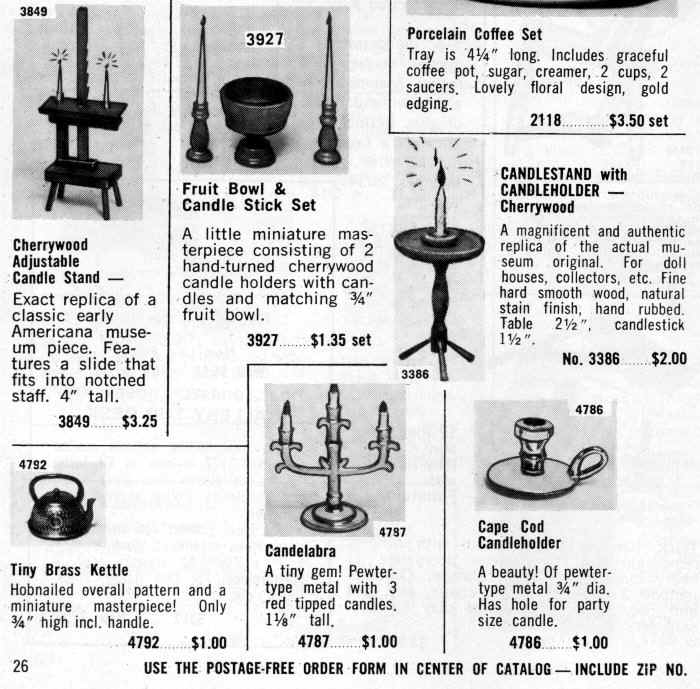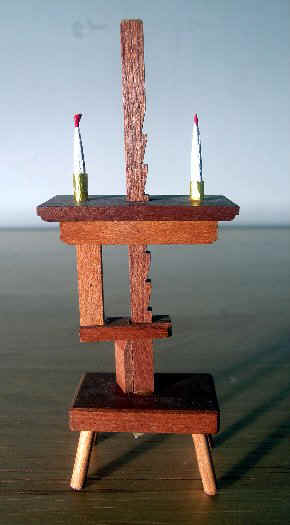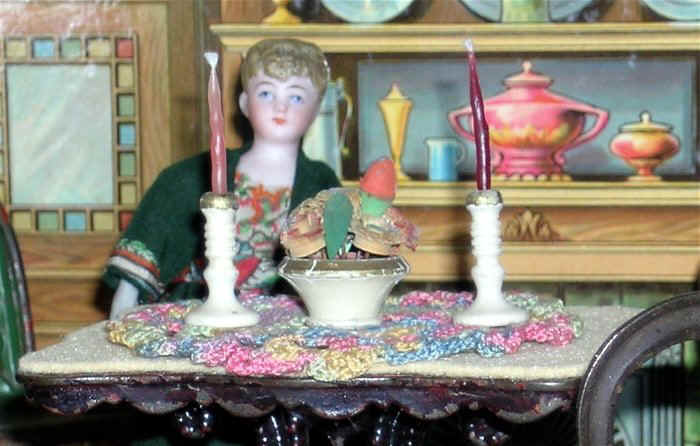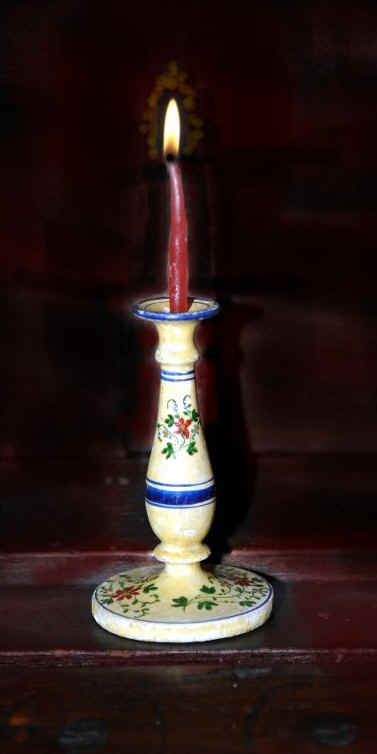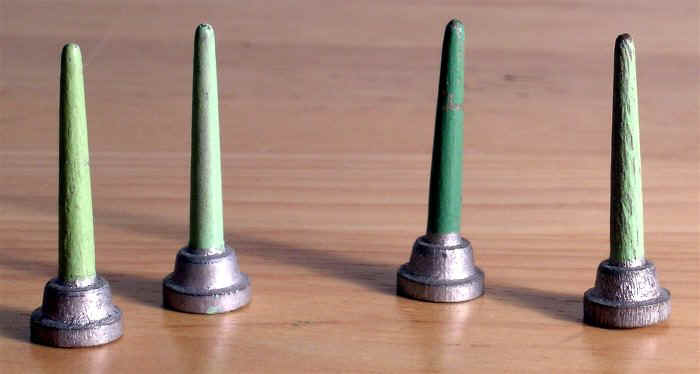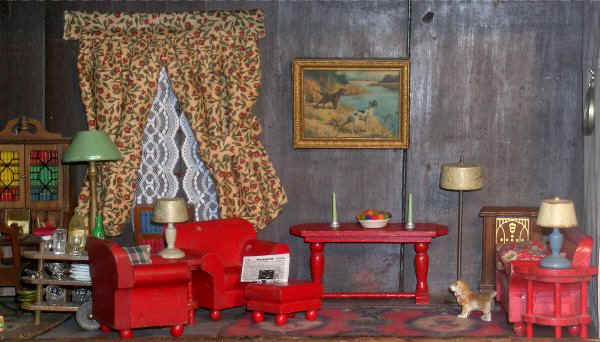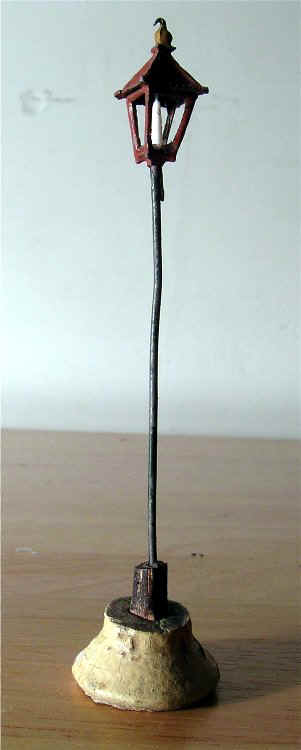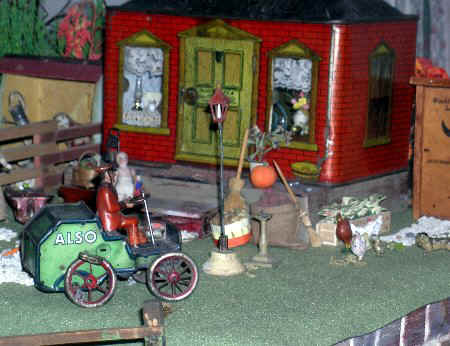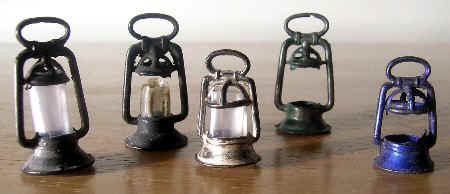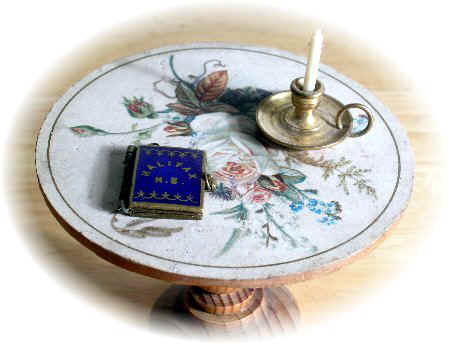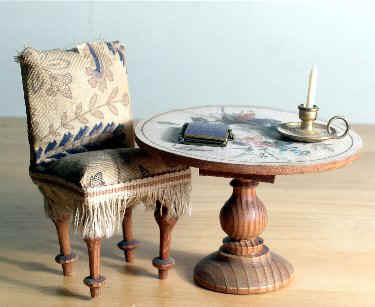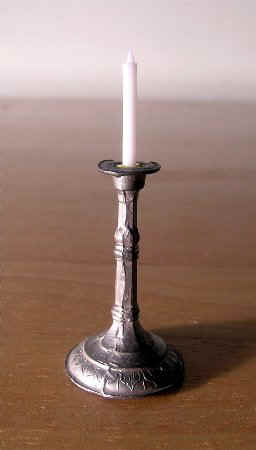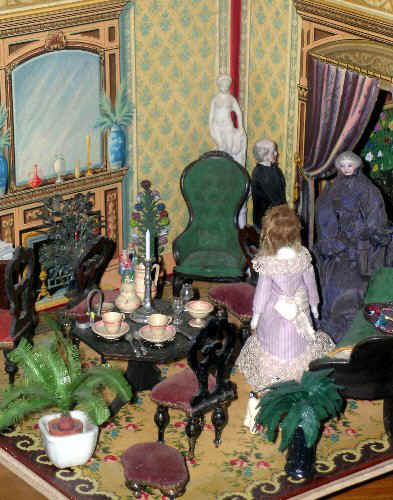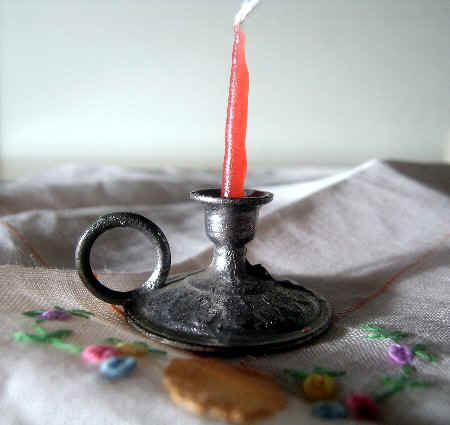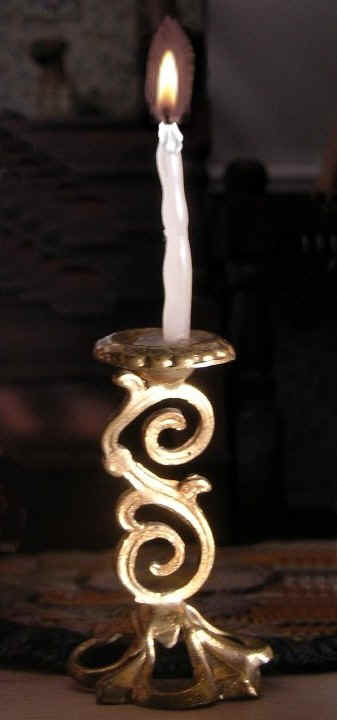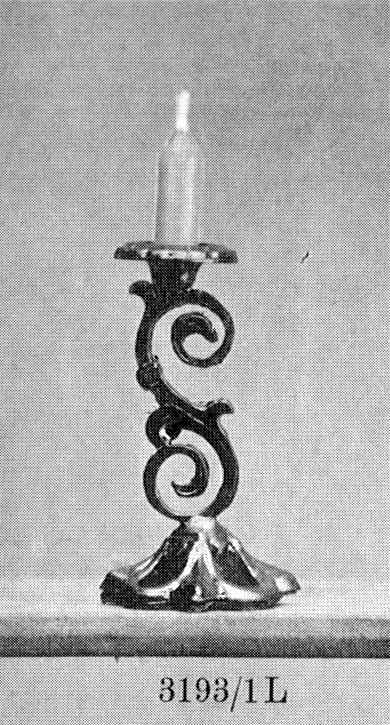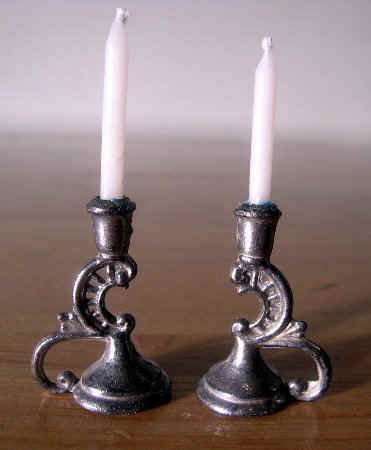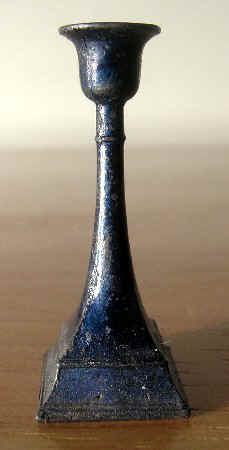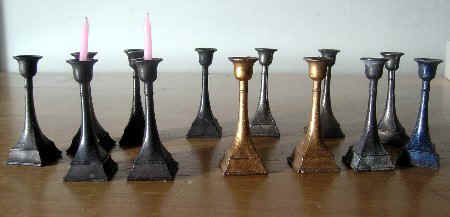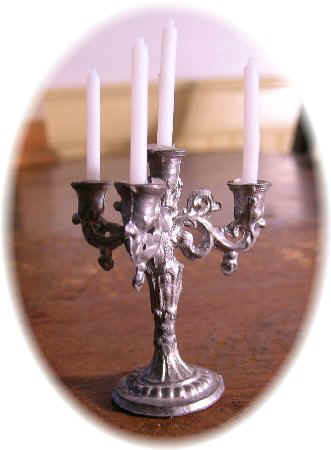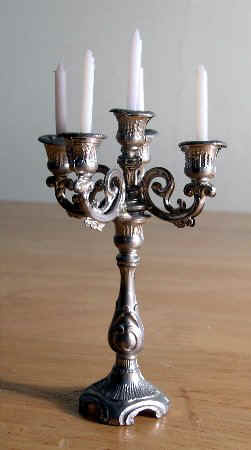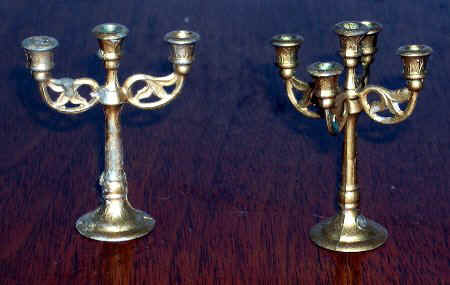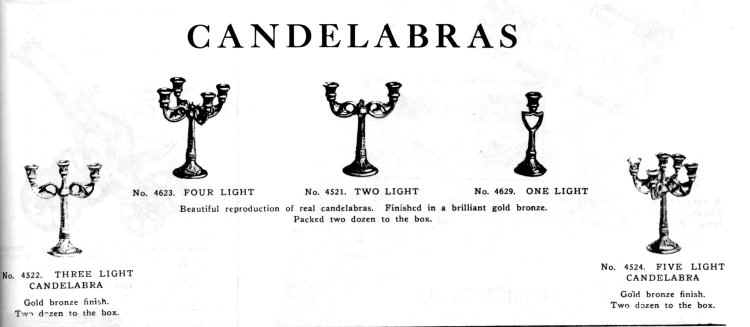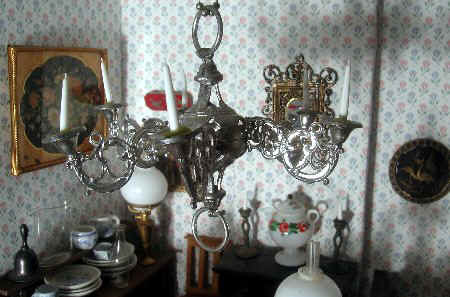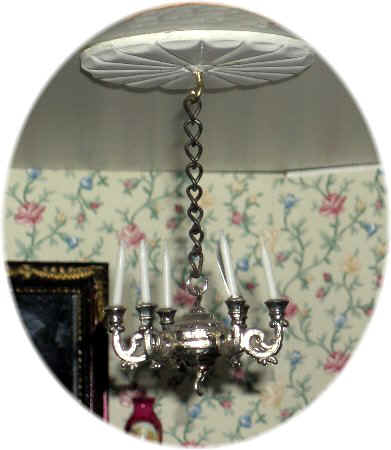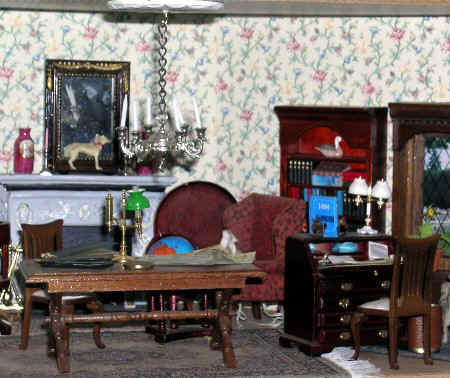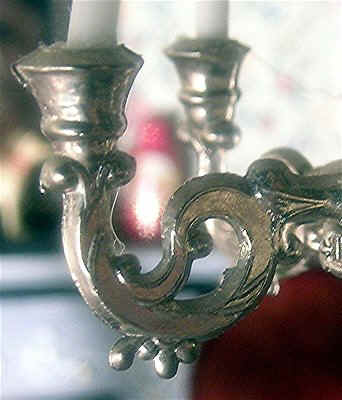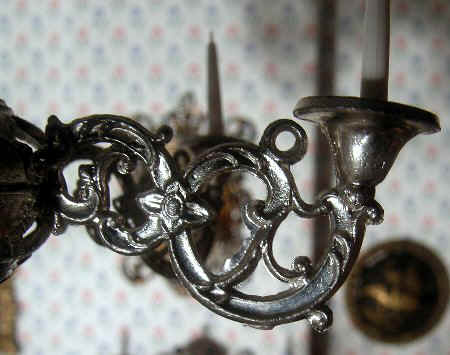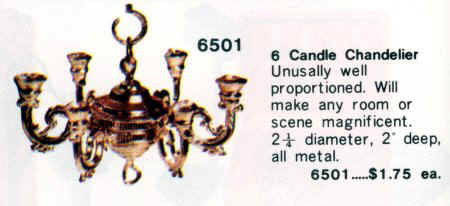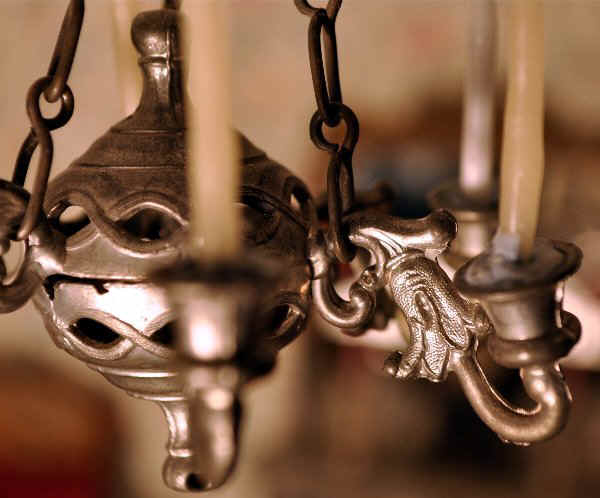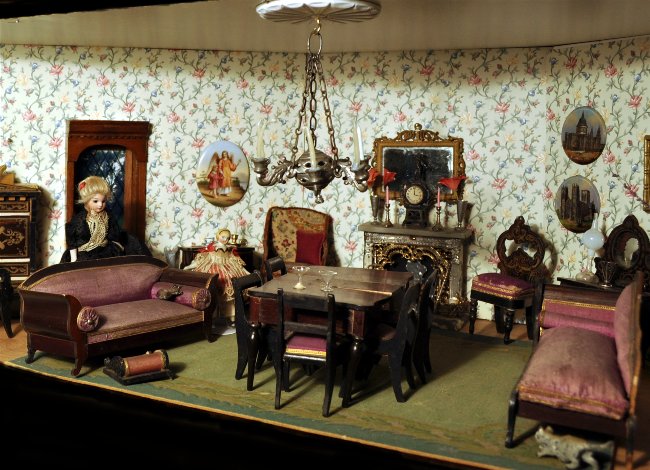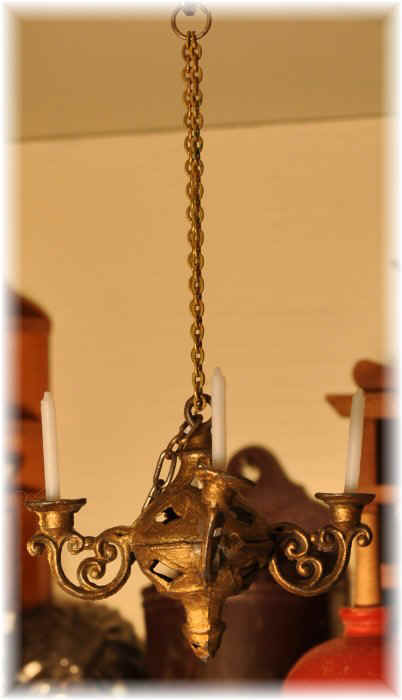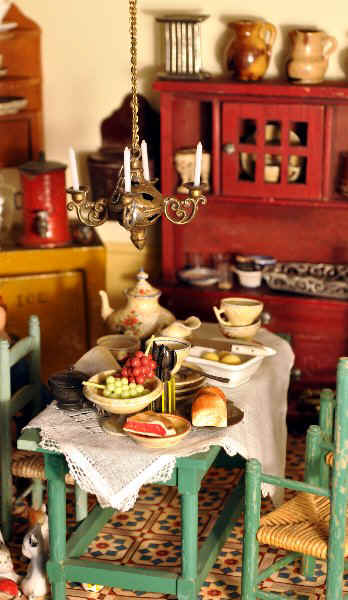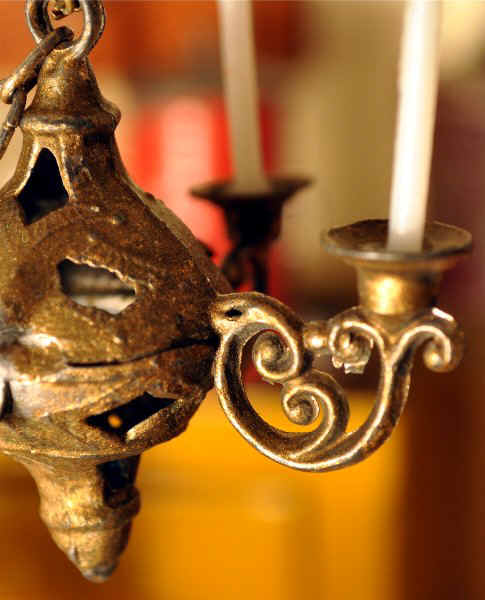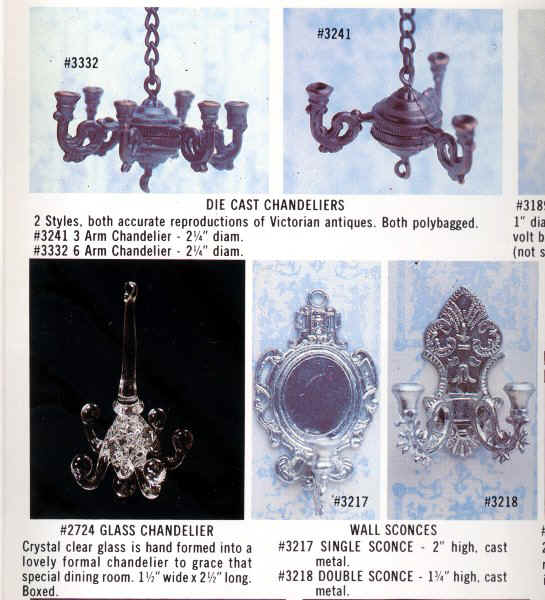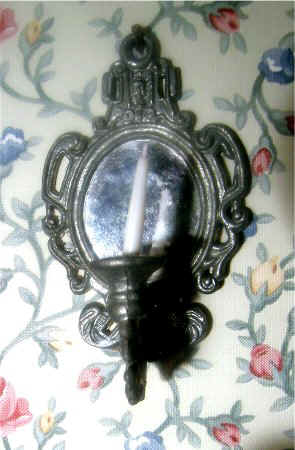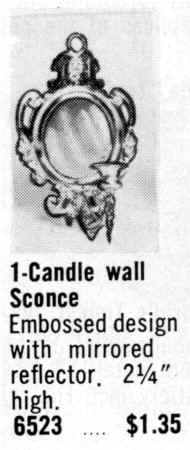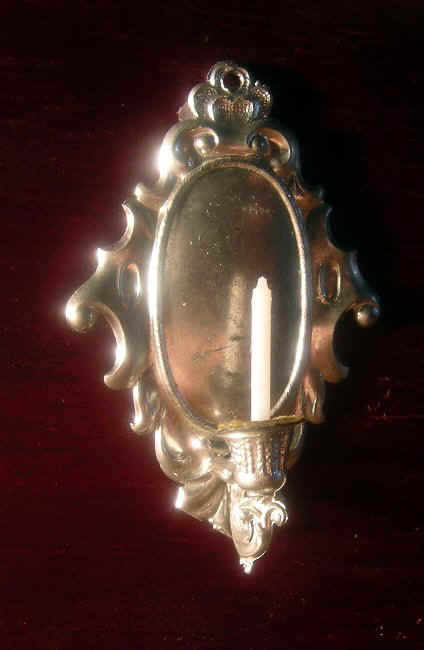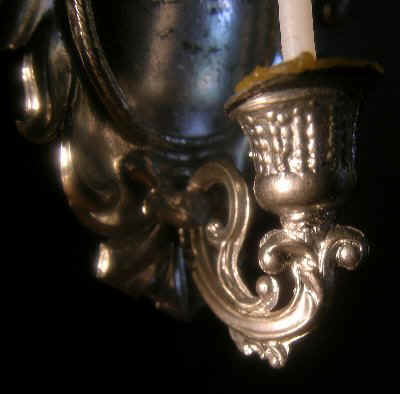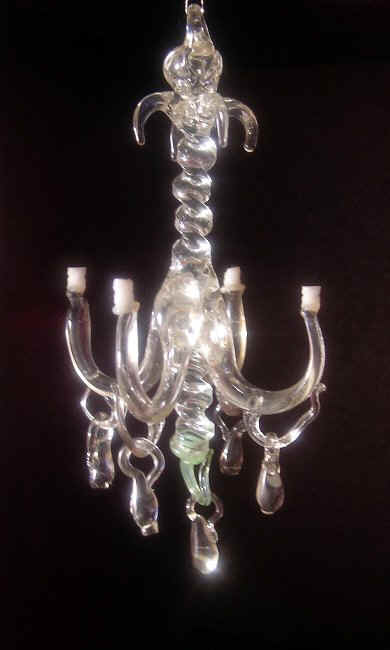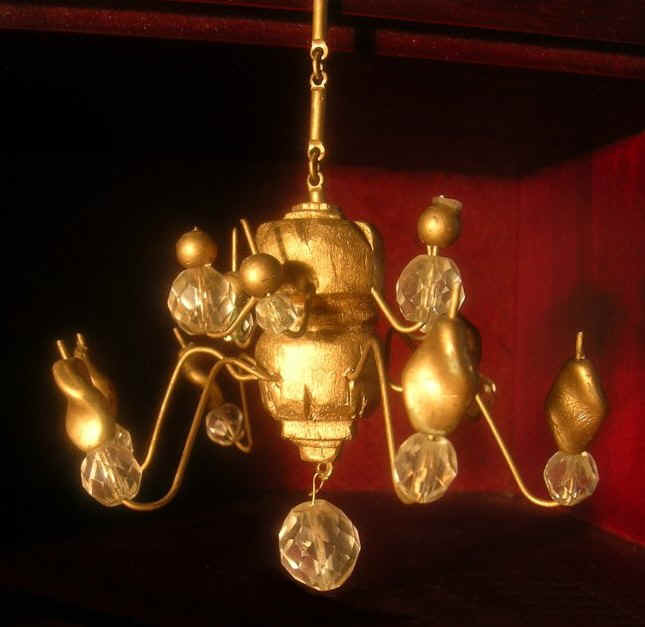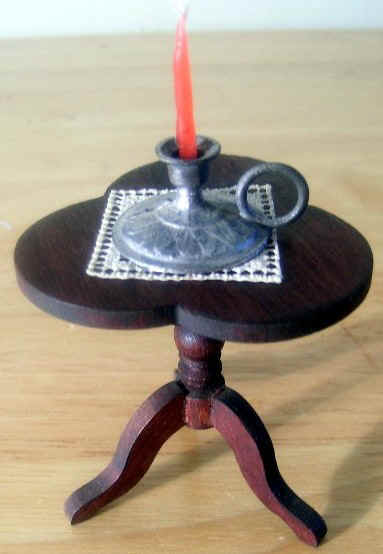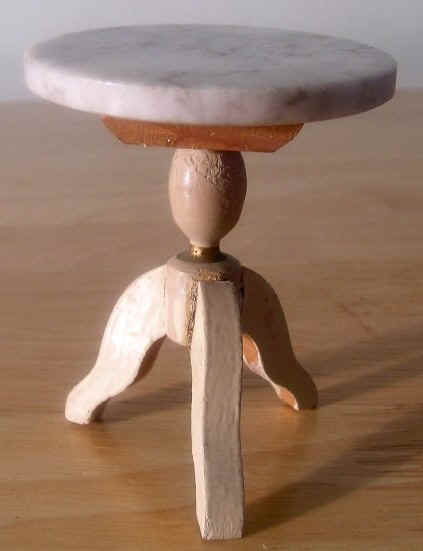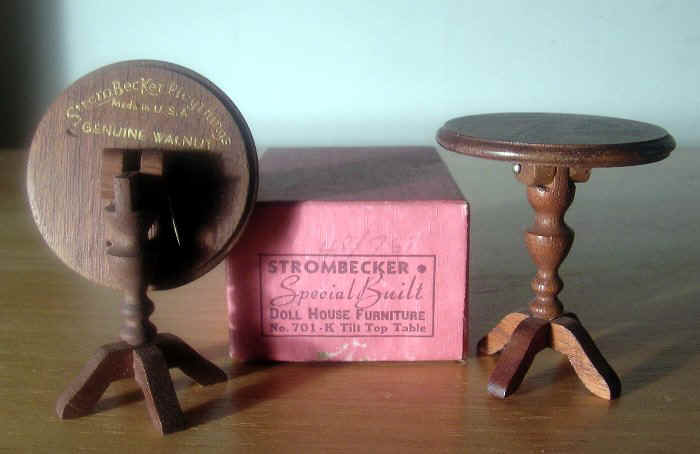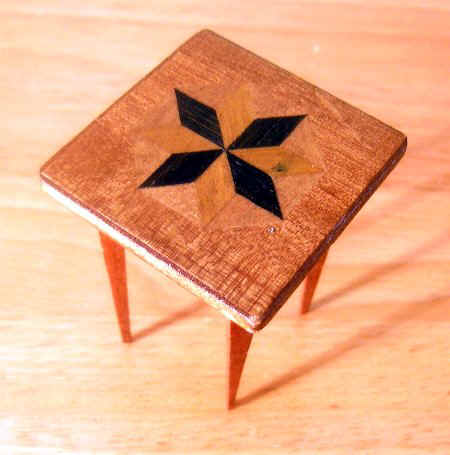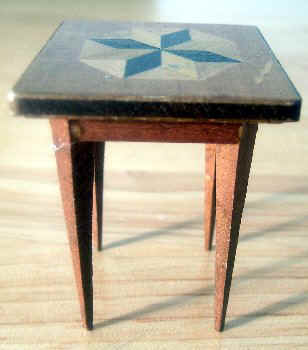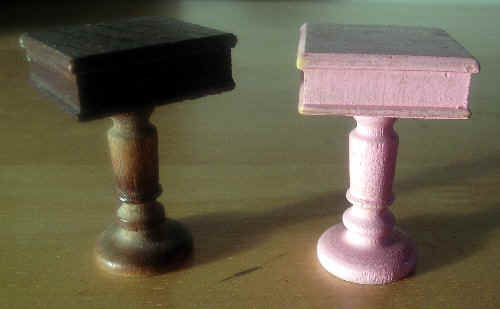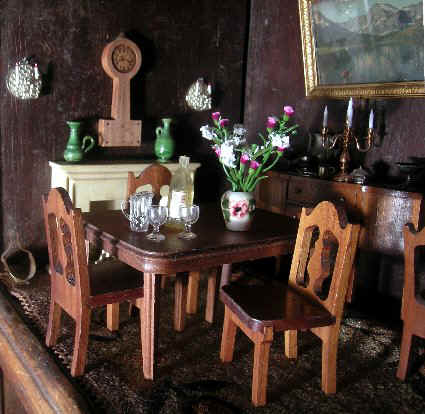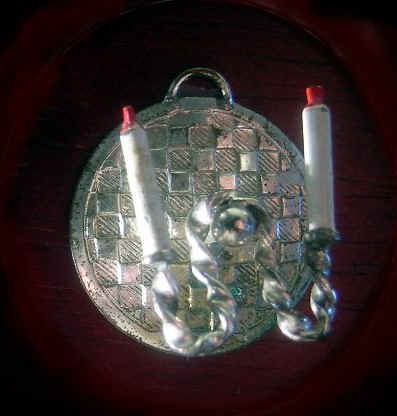|
selected examples of candle, oil, gas & electric light fixtures for dollhouses, 1890-1990 by Jennifer McKendry home page photography by Jennifer McKendry© (to go directly to the next section on oil lamps, click here )
actual brass candlestick, early 19th century Acquiring appropriate example of lights for dollhouses of various ages gives the collector a sense of satisfaction: historical accuracy is achieved, fixtures are attractive, and -- in the case of dollhouses with wiring or batteries -- an element of reality is present when the lights are "on". The years from c1890 to c1920 are intriguing as the technology for lighting houses changed from candles, oil (kerosene) and gas to electricity. Pre 1920 fixtures are difficult to find making them valuable. Their authenticity can be hard to determine, particularly when purchased from photographs and descriptions third-hand, such as on web-based auctions or sellers. The problem is that from the 1960s on miniature "colonial" artifacts were reproduced for adult collectors. It is, therefore, too simplistic to place types of lighting fixtures in chronological order to determine their age. Other factors, such as place of origin and material, are important. For example, a lamp labelled "Made in China" is likely relatively recent in manufacture and plastic components suggest a post 1940 date. Unidentified glass lamps are the hardest to feel certain about their age. Fixtures with recent original electrical wiring are easy to identify as modern (old wiring, however, can be found on early 20th century lights). In this 1975 catalogue from Federal Smallwares (distributors of Shackman products made mainly in Japan, China and Indonesia), New York, the dollhouse lights range from "colonial" and "Victorian" candle holders to "antique" oil lamps to contemporary electric lamps. Some are made from plastic but others from metal and glass, as the originals had been. Many were distributed without identifying labels and those with glued-on "Made in..." labels may have lost them over the years. There is, of course, nothing wrong with collecting anything shown here but you don't want to pay over $100 for an antique chandelier, described as c1900, and receive a Shackman 1975 example, worth much less.
CANDLE HOLDERS Candles have been a source of illumination throughout the 19th and 20th centuries but their importance diminished once kerosene or oil became popular in the 1860s. Oil was considered a safe fuel and gave superior light to candles. The latter, however, was historically a cheap and readily available light, particularly for those living in areas not serviced by gas or electricity such as villages and farms, and are kept on hand today for those times of unreliable electric power. Paradoxically, this pragmatic aspect lived with an aesthetic appreciation of the romantic quality of candlelight. Out of necessity the poor might need to light their homes with lard-based candles held in tin scounces and sticks but, at the same time, the rich lit bees-wax candles in lavish silver candelabra and chandeliers. Even in the mansions of the rich, candles in plainer holders and for practical purposes might be used in the service areas and servants' quarters. They were also handy to carry in hallways and into dark rooms. notes: * measurements do not include the candles, which are mainly modern in these photographs * defects in casting, moulding and finishes are more apparent and distracting in close photographs than when the miniatures are displayed in an appropriate setting
Tin wall scounce holding an original candle, 1½ inches high, late 19th century. Hanging on the wall (right hand side of photo) is a painted metal match holder (see right), just under 2 inches long below left Tin match holder, ¾ inch long, perhaps American
Tin safety match holder, ¾ inch long, English, 1930s
Pair of tin candle holders on the side walls of a tin kitchen by Stevens & Brown of Cromwell, Connecticut; catalogue of 1872
Simple tin candleholder in a kitchen set offered in the 1893 Carl Stirn catalogue, New York
Federal Smallwares, New York, catalogue, not dated, 1970s, showing various candle holders of wood or pewter, including an adjustable candle stand similar to this one, which is labelled "Fomerz Japan"; the original of this device would have been in use during the late 18th and early 19th centuries; the miniature is part of the second half of the 20th century enthusiasm for displaying "pioneer" life
German wood candlesticks painted gold and white, typically part of a set for the table, late 19th-early 20th centuries
Painted treen candleholder, German, 2 inches high without candle
Plain candle holders made from painted wood, 1¼ inches high (including the wood candle), manufactured by Strombecker, Illinois, 1930s & '40s; these were made in an era dominated by electricity and their role was more as an ornament than a necessity for lighting
Metal outdoor candle lamp, 5½ inches high (including replacement base), late 19th century Metal lanterns with celluloid inserts by Toosietoy, Chicago, 1930s, smallest 1 inch high; some were used as Monopoly tokens in 1935
Brass chamber candlestick, saucer ¾ inch diameter; these are difficult to date unless they are impressed with the country of origin; examples this small in scale are difficult to find; the wide saucers were considered safe for carrying and use in bedrooms
Metal candlestick with floral pattern in relief, likely German, late 19th - early 20th centuries
Metal candlestick with floral pattern in relief, likely German, late 19th - early 20th centuries
Ormolu candlestick shown in an undated Erhard & Söhne, Germany, catalogue but likely early 20th century; height of metal just under 1½ inches high; the S form, typical of Rococo Revival style, forms vines and breaks into leaves. note: For readers interested in products made by the Erhard & Söhne Company, see Swantje Köhler, Ormolu Dollhouse Accessories, Metal Toys from the Erhard & Söhne Company, 2007.
Metal candlesticks, origins unknown
Metal candlesticks, 1¾ inches high, origins unknown; these turn up frequently enough to suggest they were made the the third or fourth decade of the 20th century; the design is a pleasing classical shape
Metal 5-candle candelabra, likely German and late 19th-early 20th centuries; on left, 1½ inches high and , on the right, 2½ inches high; a candelabra similar to the one on the right is shown in the 1913 catalogue of the American store F.A.O. Schwarz, which imported German toys
Metal candelabra, one with 3 holders and the other with 5, made by Tootsietoy, Chicago; see advertisement of 1925 below showing examples for 2 to 5 candles, as well as a single candle in a holder with an open shield in the post; 2½ inches high; this scale is too large for the usual line of Tootsietoy furniture and must have been marketed for 1:12 dollhouses
Metal 6-arm chandelier marked Germany; one of a pair; note the relatively small cups for candles (in contrast with chandeliers with wide cups to hold globes lit by gas or oil); a detail is shown further below
Metal 6-arm chandelier, distributed by the American firm Shackman in the 1970s & '80s; "Japan" impressed on the body; see detail and advertisements below (the other lamps in the room are modern reproductions of old styles); the chain is made from a real bracelet
Comparing details of the earlier German chandelier on the left with the modern Shackman one on the right: the older example is more finely cast and with sharper detailing
Federal Smallwares catalogue, undated, 1980s
German chandelier, 6 arms, body with intwined running vine, textured flowers on arms, late 19th century
Pleasing, simple, metal chandelier with four arms; lozenge piercing on body, C-scrolls on arms; German, late 19th century
above Federal Smallwares catalogue, undated, 1970s, showing the metal wall scounce on the left; the oval "mirror" is an obvious imitation, as is suggested in the description from another Federal Smallwares undated catalogue, in which it sold for $1.35 on the right
Metal wall scounce marked "Germany", early 20th century
Glass chandeliers and scounces are particularly hard to date
Painted wood, facetted clear beads and wire 6-arm chandelier, origins unknown
Tripod candle or lamp tables from Germany, late 19th - early 20th centuries; red-stained natural wood with a trefoil tilt-top on the left and white and gold paint over wood with a fixed marble top on the right
Walnut tilt-tip pedestal candle or lamp table made in the American firm Strombecker in 1938. The design is a revival of mid 18th to mid 19th centuries tables.
A particularly attractive lamp table made in Japan, imported by Shackman and shown in the Federal Smallwares catalogue of 1975; it features tapering legs and a top ornamented with geometric enlay; the price was $2.75
Strombecker natural and painted pedestal bedside tables, no doubt meant to hold electric lamps, but descendants of the candle tables from the previous century; sold in the USA in 1934
Metal wall scounce with a pair of candles and a checkerboard reflector from the 1940s, 1 inch diameter N.B. - please click here to continue the story of "Lights" (section on oil lamps) history of dollhouses GALLERY of IMAGES of dollhouses & furnishings EARLY_FURNISHINGS dolls for dollhouses 1 references on dollhouses & miniatures
|



